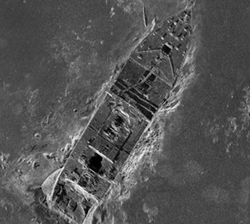|
Titanic Wreck Site Mapped,
Featured on History Channel Documentary
By Rossella Lorenzi
From Discovery News
Posted April 2012
The first comprehensive map of the Titanic wreck site has been created as researchers pieced together some 130,000 photos taken by underwater robots. The map shows debris and parts of the ship scattered across a 15-square-mile patch of ocean floor. The detailed images might provide new clues about what happened after the "unsinkable" luxury liner hit an iceberg and sank on April 15, 1912, killing more than 1,500 of the 2,200 passengers and crew on board.
The new findings will be detailed during a two-hour History channel documentary on April 15, exactly 100 years after the Titanic settled at the bottom of the North Atlantic. Computer simulations will re-enact the sinking in reverse, bringing pieces of Titanic’s wreckage back to the surface and reassembling the ship in a virtual hangar.
|

|
Bow of the Titanic taken from the map of the 3-by-5-mile debris field. (Photo: RMS Titanic, Inc. and Discovery.com.)
|
The wreck was found on Sept. 1, 1985 about 13 miles from the last position recorded before the ship sank on her maiden voyage from Southampton, England. A deep canyon lies some 3.5 nautical miles west of the wreck site—had the ship landed there, she might never have been found.
Debris abound in the so-called "hell's kitchen," an area of the seabed scattered with broken china, pots, pans and other cooking tools. http://news.discovery.com/history/titanic-unknown-child-identified-110426.html
Other features on the mapped wreck site include a pile of rubble identified as "deckhouse debris": a 60-foot long chunk of the side of the ship, five of the ship's huge boilers, and pieces of the ship's bottom.
"You really begin to understand how violently the ship tore itself apart when it went down and landed all over this enormous footprint on the bottom of the ocean," said David Alberg, Sanctuary Superintendent for NOAA’s Monitor National Marine Sanctuary.
Titanic expedition co-leader David Gallo, director of special projects at Woods Hole Oceanographic Institution in Falmouth, Mass., said, “It's not the first time that the Titanic wreck site has been mapped. The first attempts began soon after the doomed liner was discovered in 1985. Explorers used photos taken with cameras aboard remotely controlled vehicles, which did not hazard too far from the bow and stern.”
Therefore, all the maps are incomplete, covering only fragmented portions of the wreck area. Up to 40% of the wreck site has not been mapped.
|